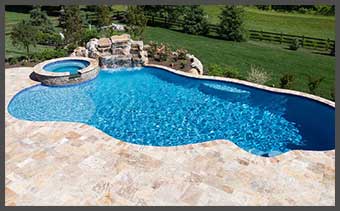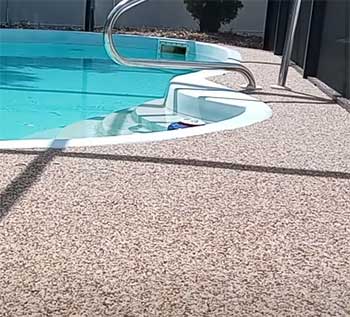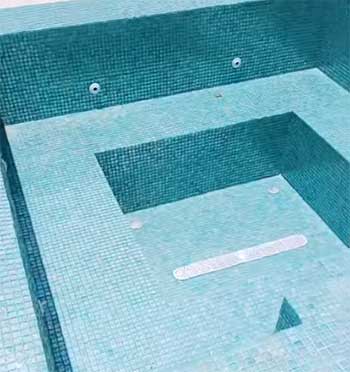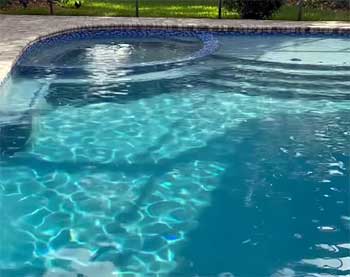I’ve always dreamed of a backyard pool that’s both a visual stunner and a practical choice for years of splashing fun. But when it came time to pick a finish, I found myself torn between quartz and pebble.
Both promise durability and beauty, but which one truly delivers for my needs?
In this article, I’ll walk you through my journey of comparing quartz and pebble pool finishes, breaking down their pros and cons, key features, and what they mean for your pool. By the end, you’ll have a clear picture to make an informed choice for your own backyard oasis.
A Brief Comparison Table
| Feature | Quartz Pool Finish | Pebble Pool Finish |
| Durability | Lasts 10-15 years with proper care | Lasts 15-25 years, often longer |
| Texture | Smooth, polished, gentle on feet | Textured, natural, can feel rough |
| Aesthetic | Shimmery, modern, vibrant colors | Earthy, natural, lakebed-like vibe |
| Cost | $3,500-$8,000 (20,000-gal pool) | $6,000-$12,000 (20,000-gal pool) |
| Maintenance | Moderate; needs careful water balance | Low; resists stains and chemicals |
| Customization | Wide color range, less pattern variety | Extensive color and texture options |
| Comfort | Soft, ideal for sensitive feet | Grippy, but may be harsh for some |
| Installation Time | 3-5 days, intensive startup process | 5-7 days, simpler startup |
| Warranty | Typically 10 years | Often 15-20 years or lifetime |
| Slip Resistance | Good, but less than pebble | Excellent, naturally non-slip |
This table gives you a snapshot of what’s at stake. Now, let’s explore these finishes in detail to help you decide which one fits your pool and lifestyle.
Understanding Quartz Pool Finishes

Quartz pool finishes caught my eye with their sleek, sparkly allure.
They’re made by blending crushed quartz crystals with white cement and pigments, creating a surface that’s smoother than traditional plaster but tougher too.
The quartz itself is a hard, natural mineral, which gives the finish a leg up over old-school marcite plaster that used marble dust.
I was drawn to the way quartz reflects light, making the water shimmer like a jewel under the sun.
Pros of Quartz Pool Finishes
The first thing that struck me about quartz was its aesthetic punch. The crystals catch the light, giving your pool a vibrant, almost magical glow. You can choose from a rainbow of colors—blues, greens, teals, even deep blacks—that make your pool pop against your backyard.
I loved the idea of a midnight blue quartz finish that would turn my pool into a starry night scene.
Durability is another win. Quartz lasts about 10-15 years with proper care, outpacing traditional plaster’s 7-10 years. The quartz crystals are less porous than marble, so they resist staining and etching better than basic plaster.
This means fewer headaches if your pool chemistry goes slightly off-kilter. I also appreciated the smooth texture—perfect for my kids who love cannonballing without scraping their feet.
Cost-wise, quartz is a middle-ground option. For a 20,000-gallon pool, you’re looking at $3,500-$8,000, which is pricier than plaster but often cheaper than pebble.
Installation takes about 3-5 days, though it requires a meticulous startup process—brushing twice daily for a month to ensure even curing. I found this a bit daunting, but the result is a polished, slip-resistant surface that’s safe and comfortable.
Cons of Quartz Pool Finishes
But quartz isn’t perfect. The cement in the mix is still exposed to pool water, which can lead to discoloration or etching over time, especially if you’re not religious about water chemistry.
I learned that unbalanced pH or high chlorine levels can cause blotchy spots, which would drive me nuts on a pristine finish. Quartz also has a shorter lifespan than pebble, meaning I’d need to resurface sooner, which could add up in costs.
The texture, while smooth, isn’t as grippy as pebble. If you’ve got a pool full of rambunctious swimmers, you might want more traction. Also, while quartz offers plenty of color options, it lacks the intricate patterns you get with pebble finishes. I found myself wishing for a bit more visual depth to mimic a natural water body.
Exploring Pebble Pool Finishes

Pebble finishes, like those from PebbleTec, were a game-changer when I saw them in person. They’re made by mixing small, smooth pebbles—often river stones or glass beads—with cement, then exposing the pebbles by washing away the top layer.
The result is a textured, natural look that feels like you’re swimming in a mountain stream. I was instantly smitten with the organic vibe, but there’s more to pebbles than just aesthetics.
Pros of Pebble Pool Finishes
Durability is where pebble shines. These finishes can last 15-25 years, sometimes more, with proper maintenance. The pebbles are incredibly tough, resisting stains, fading, and chemical damage far better than quartz or plaster.
I loved knowing that a pebble finish could handle my less-than-perfect pool maintenance habits without looking worse for wear.
The aesthetic options blew me away. With brands like PebbleTec offering over 60 combinations, you can customize everything from pebble size to color blends. Want a tropical lagoon with vibrant blues and greens? Done. Prefer an earthy lakebed with tans and grays?
You got it. The texture also adds a non-slip quality, which is a huge plus for safety, especially if you’ve got kids or elderly swimmers.
Cost is higher—$6,000-$12,000 for a 20,000-gallon pool—but the longevity makes it a solid investment. Installation takes 5-7 days, with a simpler startup process than quartz, which was a relief.
Plus, many pebble finishes come with warranties stretching 15-20 years, sometimes even lifetime guarantees on materials. I felt like this was a finish that could grow with my family.
Cons of Pebble Pool Finishes

The biggest drawback for me was the texture.
Pebble finishes are rougher than quartz, which some swimmers—especially kids—might find uncomfortable.
I tested a friend’s pebble pool and noticed my feet felt a bit tender after a long swim.
Smoother options like PebbleSheen or PebbleFina exist, but they’re pricier and still not as soft as quartz.
Cost is another hurdle. Pebble finishes are a premium choice, and the price reflects that. If your budget is tight, quartz might be easier to swallow. Cleaning can also be trickier due to the textured surface, which can trap algae or debris if you’re not vigilant.
I worried about spending extra time scrubbing to keep it pristine, especially in a dusty area.
Key Features of Quartz And Pebble Pool Finish That Matter
As I weighed my options, I zeroed in on a few features that define quartz and pebble finishes. These became my guideposts for deciding what mattered most for my pool.

- Durability and Longevity: Pebble takes the crown here. Its 15-25 year lifespan dwarfs quartz’s 10-15 years, making it the go-to for anyone planning to stay in their home long-term. Quartz is no slouch, though—it’s a big step up from traditional plaster and holds up well against moderate chemical fluctuations.
- Aesthetic Appeal: Quartz offers a polished, modern look with a shimmery finish that’s perfect for sleek, contemporary designs. Pebble, on the other hand, delivers a natural, textured aesthetic that mimics lakes or rivers. Your choice depends on whether you want your pool to feel like a luxury spa or a wilderness retreat.
- Texture and Comfort: Quartz is smoother, making it gentler on feet and swimsuits. It’s ideal for families with young kids or anyone who prioritizes comfort. Pebble’s textured surface provides better grip but can feel abrasive, though smoother variants like micro pebble help bridge the gap.
- Maintenance Needs: Pebble is more forgiving, resisting stains and chemical damage better than quartz. Quartz requires stricter water chemistry management to avoid etching or discoloration. Both need regular brushing, but pebble’s texture can hide minor imperfections, which I found reassuring.
- Cost and Installation: Quartz is generally more budget-friendly upfront, but pebble’s longer lifespan can make it more cost-effective over time. Installation for both is straightforward, but quartz’s intensive startup process demands more effort. Pebble’s simpler startup was a point in its favor for me.
My Decision-Making Process

Choosing between quartz and pebble felt like picking between two great vacation spots—each had its charm, but neither was perfect.
I started by listing my priorities: I wanted a pool that looked amazing, lasted long, and didn’t break the bank.
Safety was also key since my kids would be splashing around daily.
I leaned toward quartz at first because of its smooth texture and lower cost. The idea of a sparkly, teal-colored pool was hard to resist, and I liked that it wouldn’t scrape my kids’ feet.
But then I visited a neighbor’s pool with a PebbleTec finish, and the natural, lagoon-like vibe won me over. The durability was a huge selling point—I didn’t want to resurface every decade. The rougher texture gave me pause, but I learned that smoother options like PebbleSheen could soften the feel without sacrificing longevity.
Budget was a sticking point. Quartz was tempting because it saved me a few thousand dollars upfront, but I crunched the numbers and realized pebble’s longer lifespan could save me money in the long run.
Maintenance was another factor—my pool maintenance skills are average at best, so pebble’s stain resistance was a big plus.
Real-World Considerations
I also thought about how my pool would fit into my lifestyle. Living in a sunny area, I knew UV exposure would be intense, so pebble’s fade resistance was appealing. My kids are rough on surfaces, so the non-slip quality of pebble felt like a safer bet.
But I couldn’t shake the comfort factor—quartz’s smoothness was a big draw for their sensitive feet.
I talked to a local pool contractor who emphasized water chemistry. He warned that quartz needs more diligent monitoring to prevent etching, while pebble could handle occasional lapses. This tipped the scales toward pebble, especially since I’m not always on top of testing my water.
Balancing Aesthetics and Practicality
Aesthetics played a huge role. I wanted a pool that felt like an extension of my backyard’s vibe—a mix of modern and natural. Quartz’s shimmery finish matched my modern patio furniture, but pebble’s earthy tones blended better with my stone deck.
I also considered resale value. A durable, high-end pebble finish could boost my home’s appeal if I ever sell, while quartz might not stand out as much.
The Verdict for My Pool
After weeks of back-and-forth, I chose a pebble finish—specifically, a PebbleSheen blend in a soft blue-green. The durability, safety, and natural look won me over, and the smoother texture addressed my concerns about comfort.
It cost more upfront, but I’m betting on the long-term savings and low maintenance. That said, quartz was a close second, and I’d recommend it to anyone on a tighter budget or prioritizing a silky-smooth feel.
Frequently Asked Questions (FAQ)
It depends on your needs. Quartz is smoother and cheaper, ideal for comfort and budget. PebbleTec lasts longer (15-25 years vs. 10-15) and resists stains better, making it better for durability and low maintenance.
PebbleTec can feel rough on feet, especially for kids, and is pricier ($6,000-$12,000 vs. quartz’s $3,500-$8,000). Its textured surface may trap debris, requiring more cleaning effort.
Yes, quartz is durable (10-15 years), smooth, and offers vibrant colors with a shimmery look. It’s a great middle-ground option but needs careful water chemistry to avoid staining.
A quartzon (quartz) pool finish typically lasts 10-15 years with proper maintenance, though lifespan can vary based on water chemistry and usage.
Wrapping Up
Choosing between quartz and pebble pool finishes is no small decision—it’s about balancing beauty, durability, and your wallet. I found pebble’s long-lasting, natural charm perfect for my family, but quartz’s smooth, sparkly vibe might be your dream.
Think about what matters most: a silky feel or rugged longevity? A modern shimmer or a lakebed aesthetic? Whatever you pick, you’re crafting a backyard escape that’ll bring joy for years.
Take your time, talk to pros, and choose a finish that makes your pool uniquely yours.
